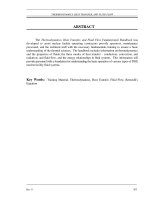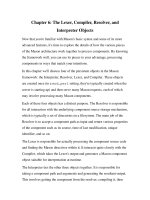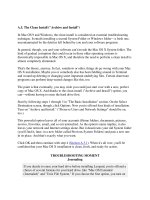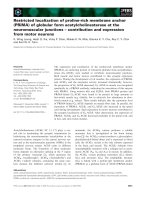The CMU Pose, Illumination, and Expression (PIE) Database potx
Bạn đang xem bản rút gọn của tài liệu. Xem và tải ngay bản đầy đủ của tài liệu tại đây (669.68 KB, 6 trang )
Appeared in the 2002 International Conference on Automatic Face and Gesture Recognition
The CMU Pose, Illumination, and Expression (PIE) Database
Terence Sim, Simon Baker, and Maan Bsat
The Robotics Institute, Carnegie Mellon University
5000 Forbes Avenue, Pittsburgh, PA 15213
Abstract
Between October 2000 and December 2000 we collected a
database of over 40,000 facial images of 68 people. Us-
ing the CMU 3D Room we imaged each person across 13
different poses, under 43 different illumination conditions,
and with 4 different expressions. We call this database the
CMU Pose, Illumination,and Expression (PIE)database. In
this paper we describe the imaging hardware, the collection
procedure, the organization of the database, several poten-
tial uses of the database, and how to obtain the database.
1 Introduction
People look very different depending on a number of fac-
tors. Perhaps the three most significant factors are: (1) the
pose; i.e. the angle at which you look at them, (2) the illumi-
nation conditions at the time, and (3) their facial expression;
i.e. whether or not they are smiling, etc. Although several
other face databases exist with a large number of subjects
[
Philips et al., 1997
]
, and with significant pose and illu-
mination variation
[
Georghiades et al., 2000
]
,wefeltthat
there was still a need for a database consisting of a fairly
large number of subjects, each imaged a large number of
times, from several different poses, under significant illu-
mination variation, and with a variety of facial expressions.
Between October 2000 and December 2000we collected
such a database consisting of over 40,000 images of 68 sub-
jects. (The total size of the database is about 40GB.) We
call this database the CMU Pose, Illumination, and Expres-
sion (PIE) database. To obtain a wide variation across pose,
we used 13 cameras in the CMU 3D Room
[
Kanade et al.,
1998
]
. To obtain significant illumination variation we aug-
mented the 3D Room with a “flash system” similar to the
one constructed by Athinodoros Georghiades, Peter Bel-
humeur, and David Kriegman at Yale University
[
Georghi-
ades et al., 2000
]
. We built a similar system with 21 flashes.
Since we captured images with, and without, background
lighting, we obtained
different illumina-
tion conditions. Finally, we asked the subjects to pose with
several different“expressions.” In particular,we asked them
to give a neutral expression, to smile, to blink (i.e. shut their
eyes), and to talk. These are probably the four most fre-
quently occurring “expressions” in everyday life.
Figure 1: The setup in the CMU 3D Room
[
Kanade et al., 1998
]
.
The subject sits in a chair with his head in a fixed position. We
used 13 Sony DXC 9000 (3 CCD, progressive scan) cameras with
all gain and gamma correction turned off. We augmented the 3D
Room with 21 Minolta 220X flashes controlled by an Advantech
PCL-734 digital output board, duplicating the Yale “flash dome”
used to capture the database in
[
Georghiades et al., 2000
]
.
Capturing images of every person under every possible
combination of pose, illumination, and expression was not
practical because of the huge amount of storage space re-
quired. The PIE database therefore consists of two major
partitions, the first with pose and illumination variation, the
second with pose and expression variation. There is no
simultaneous variation in illumination and expression be-
cause it is more difficult to systematically vary the illumi-
nation while a person is exhibiting a dynamic expression.
In the remainder of this paper we describe the capture
hardware in the CMU 3D Room, the capture procedure, the
organization of the database, several possible uses of the
database, and how to obtain a copy of it.
2 Capture Apparatus and Procedure
2.1 Setup of the Cameras: Pose
Obtaining images of a person from multiple poses requires
either multiple cameras capturing images simultaneously,
or multiple “shots” taken consecutively (or a combination
of the two.) There are a number of advantages of using
multiple cameras: (1) the process takes less time, (2) if the
cameras are fixed in space, the (relative) pose is the same
1
c02
f15
c25
f22
f16
f17
f13
f14
c22
c37
f21
f12
f09
c05
f08
f11
c07
c27
c09
f20
f06
f07
c29
head
f19
c11
f05
f10
f18
c14
c31
f04
f03
c34
f02
Flashes
Cameras
Head
Figure 2: The xyz-locations of the head position, the 13 cameras,
and the 21 flashes plotted in 3D to illustrate their relative loca-
tions. The locations were measured with a Leica theodolite. The
numerical values of the locations are included in the database.
for every subject and there is less difficulty in positioning
the subject to obtain a particular pose, (3) if the images
are taken simultaneously we know that the imaging condi-
tions (i.e. incident illumination, etc) are the same. This final
advantage can be particularly useful for detailed geometric
and photometric modeling of objects. On the other hand,
the disadvantages of using multiple cameras are: (1) We
actually need to possess multiple cameras, digitizers, and
computers to capture the data. (2) The cameras need to be
synchronized: the shutters must all open at the same time
and we must know the correspondence between the frames.
(3) Despite our best efforts to standardize settings, the cam-
eras will have different intrinsic and extrinsic parameters.
Setting up a synchronized multi-camera imaging system
is quite an engineering feat. Fortunately, such a system al-
ready existed at CMU, namely the 3D Room
[
Kanade et al.,
1998
]
. We reconfigured the 3D Room and used it to capture
multiple images of each person simultaneously across pose.
Figure 1 shows the capture setup in the 3D Room. There
are 49 cameras in the 3D Room, 14 very high quality (3
CCD, progressive scan) Sony DXC 9000’s, and 35 lower
quality (single CCD, interlaced) JVC TK-C1380U’s. We
decided to use only the Sony cameras so that the image
quality isapproximately the sameacross the entire database.
Due to other constraints we were only able to use 13 of the
14 Sony cameras. This still allowed us to capture 13 poses
of each person simultaneously however.
We positioned 9 of the 13 camerasat roughlyhead height
in an arc from approximately a full left profile to a full right
profile. Each neighboring pair of these 9 cameras are there-
fore approximately
apart. Of the remaining 4 cam-
eras, 2 were placed above and below the central (frontal)
camera, and 2 were placed in the corners of the room where
a typical surveillance camera would be. The locations of 10
of the camerascan be seen in Figure 1. The other 3 are sym-
metrically opposite the 3 right-most cameras visible in the
figure. Finally we measured the locations of the cameras
using a theodolite. The measured locations are shown in
Figure 2. The numerical values are included in the database.
The pose of a person’s head can only be defined rela-
tive to a fixed direction, most naturally the frontal direction.
Although this fixed direction can perhaps be defined using
anatomical measurements, even this method is inevitably
somewhat subjective. We therefore decided to define pose
by asking the person to look directly at the center cam-
era (c27 in our numbering scheme.) The subject therefore
defines what is frontal to them. In retrospect this should
have beendone moreprecisely because some of the subjects
clearly introduced an up-down tilt or a left-right twist. The
absolute pose measurements that can be computed from the
head position, the camera position, and the frontal direction
(from the head position to camera c27) should therefore be
used with caution. The relative pose, on the other hand, can
be trusted. The PIE database can be used to evaluate the
performance of pose estimation algorithms either by using
the absolute head poses, or by using the relative poses to
estimate the internal consistency of the algorithms.
2.2 The Flash System: Illumination
To obtain significant illumination variation we extended the
3D Room with a “flash system” similar to the Yale Dome
used to capture the data in
[
Georghiades et al., 2000
]
. With
help from Athinodoros Georghiades and Peter Belhumeur,
we used an Advantech PCL-734, 32 channel digital out-
put board to control 21 Minolta 220X flashes. The Advan-
tech board can be directly wired into the “hot-shoe” of the
flashes. Generating a pulse on one of the output channels
then causes the corresponding flash to go off. We placed the
Advantech board in one of the 17 computers used for image
capture and integrated the flash control code into the image
capture routine so that the flash, the duration of which is
approximately 1ms, occurs while the shutter (duration ap-
proximately 16ms) is open. We then modified the image
capture code so that one flash goes off in turn for each im-
age captured. We were then able to capture 21 images, each
with different illumination, in
sec. The loca-
tions of the flashes, measured with a theodolite, are shown
in Figure 2 and included in the database meta-data.
In the Yale illumination database
[
Georghiades et al.,
2000
]
the images are captured with the room lights switched
off. The images in the database therefore do not look en-
tirely natural. In the real world, illumination usually con-
sists of an ambient light with perhaps one or two point
sources. To obtain representative images of such cases (that
are more appropriate for determining the robustness of face
recognition algorithms to illumination change) we decided
to capture images both with the room lights on and with
them off. We decided to include the images with the room
lights off to provide images for photometric stereo.
2
c07
c27
c22
c02
c37
c05
c25
c09
c31
c29 c11
c14
c34
Figure 3: An illustration of the pose variation in the PIE database. The pose varies from full left profile to full frontal and on to full right
profile. The 9 cameras in the horizontal sweep are each separated by about
. The 4 other cameras include 2 above and 2 below the
central camera, and 2 in the corners of the room, a typical location for surveillance cameras. See Figures 1 and 2 for the camera locations.
To get images that look natural when the room lights are
on, the room illumination and the flashes need to contribute
approximately the same amount of light in total. The flash
is much brighter, but is illuminated for a much shorter pe-
riod of time. Even so, we still found it necessary to place
blank pieces of paper in front of the flashes as a filter to re-
duce their brightness. The aperture setting is then set so that
without the flash the brightest pixel registers a pixel value
of around 128, while with the flash the brightest pixel is
about 255. Since the “color” of the flashes is quite “hot,”
it is only the blue channel that ever saturates. The database
therefore contains saturated data in the blue channel that is
useful for evaluating the robustness of algorithms to satura-
tion, as well as unsaturated data in both the red and green
channels, which can be used for tasks that require unsatu-
rated data, such as photometric stereo.
An extra benefit of the filtering is that the flashes are then
substantially less bright than when not filtered. There are
therefore no cases of the subjects either blinking or grimac-
ing during the capture sequence, unlike in the Yale database
(where the flashes are also much closer.) On the other hand,
a slight disadvantage of this decision is that the images that
were captured without the flashes are compressed into 0-
128 intensity levels and so appear fairly dark. This can eas-
ily be corrected, but at the cost of increased pixel noise. (We
found no easy way of temporally increasing the light level,
or opening the aperture, for the ambient only images.)
To obtain the (pose and) illumination variation, we led
each of the subjects through the following steps:
With Room Lights: We first captured the illumination
variation with the room lights switched on. We asked
the person to sit in the chair with a neutral expression
and look at the central (frontal) camera. We then cap-
tured 24 images from each camera, 2 with no flashes,
21 with one of the flashes firing, and then a final im-
age with no flashes. If the person wears glasses, we
got them to keep them on. Although we captured this
data fromeach camera, forreasons of storage space we
decided to keep only the output of three cameras, the
frontal camera, a 3/4 profile, and a full profile view.
Without Room Lights: We repeated the previous step but
with the room lights off. Since these images are likely
to be used for photometric stereo, we asked the per-
son to remove their glasses if they wear them. We
kept the images from all of the cameras this time. (We
made the decision to keep all of the images without
the room lights, but only a subset with them, to ensure
that we could duplicate the results in
[
Georghiades et
al., 2000
]
. In retrospect we should have kept all of the
images captured with the room lights on and instead
discarded more images with them off.)
2.3 The Capture Procedure: Expression
Although the human face is capable of making a wide vari-
ety of complex expressions, most of the time we see faces
in one of a small number of states: (1) neutral, (2) smil-
ing, (3) blinking, or (4) talking. We decided to focus on
these four simple expressions in the PIE database because
extensive databases of frontal videos of more complex, but
less frequently occurring, expressions are already available
[
Kanade et al., 2000
]
. Another factor that effects the ap-
pearance of human faces is whether the subject is wearing
glasses or not. For convenience, we include this variation in
the pose and expression variation partition of the database.
To obtain the (pose and) expression variation, we led
each of the subjects through the following steps:
Neutral: We asked the person to sit in the chair and look at
the central camera with a neutral expression. We then
captured a single frame from each camera.
Smile: We repeated the previous step, but this time asked
the subject to smile.
Blink: We again repeated the previous steps, but asked the
subject to close her eyes to simulate a blink.
Talking: We asked the person to look at the central camera
and speak the words “1, 2, 3,
” while we captured 2
seconds (60 frames) of video from each camera.
Without Glasses: If the subject wears glasses, we repeated
the neutral scenario, but without the glasses.
3
c27
c22
c05
Room Lights Flash f01 Flash f09
Figure 4: An example of the pose and illumination variation with
the room lights on. The subject is asked to pose with a neutral ex-
pression and to look at the central camera (c27). We then capture
24 images (for each camera): 2 with just the background illumi-
nation, 21 with one of the flashes firing, and one final image with
just the background illumination. Notice how the combination of
the background illumination and the flashes leads to much more
natural looking images than with just the flash; c.f. Figure 5.
In all these steps the room lights are lit and the flash system
is switched off. We also always captured images from all
13 cameras. However, because the storage requirements of
keeping 60 frames of video for all cameras and all subjects
is very large, we kept the “talking” sequences for only 3
cameras: the central camera, a 3/4 profile, and a full profile.
3 Database Organization
On average the capture procedure took about 10 minutes
per subject. In that time, we captured (and retained) over
600 images from 13 poses, with 43 different illuminations,
and with 4 expressions. The images are
color
images. (The first 6 rows of the images contain synchro-
nization information added by the VITC units in the 3D
Room
[
Kanade et al., 1998
]
. This information could be dis-
carded.) The storage required per person is approximately
600MB using color“raw PPM” images. Thus, the total stor-
age requirement for 68 people is around 40GB (which can
of course be reduced by compressing the images.)
The database is organized into two partitions, the first
consisting of the pose and illumination variation, the second
consisting of the pose and expression variation. Since the
major novelty of the PIE database is the pose variation, we
first discuss the pose variation in isolation before describing
the two major partitions. Finally, we include a description
of the database meta-data (i.e. calibration data, etc.)
3.1 Pose Variation
An example of the pose variation in the PIE database is
shown in Figure 3. This figure contains images of one sub-
c27
c22
c05
Flash f01 Flash f09 Flash f17
Figure 5: An example of the pose and illumination variation with
the room lights off. This part of the database corresponds to the
Yale illumination database
[
Georghiades et al., 2000
]
. We cap-
tured it to allow direct comparison with the Yale database. This
part of the database is less representative of facial images that ap-
pear in the real world than those in Figure 4 but can be used recover
3D face models using photometric stereo.
ject in the database from each of the 13 cameras. As can be
seen, there isa wide variation in pose from full profile to full
frontal. This subset of the data should be useful for evalu-
ating the robustness of face recognition algorithms across
pose. Since the camera locations are known, it can also be
used for the evaluation of pose estimation algorithms. Fi-
nally, it might be useful for the evaluation of algorithms
that combine information from multiple widely separated
views. An example of such an algorithm would be one that
combines frontal and profile views for face recognition.
3.2 Pose and Illumination Variation
Examples of the pose and illumination variation are shown
in Figures 4 and 5. Figure 4 contains the variation with the
room lights on and Figure 5 with the lights off. Compar-
ing the images we see that those in Figure 4 appear more
natural and representative of images that occur in the real
world. On the other hand, the data with the lights off was
captured to reproducethe Yale database
[
Georghiadeset al.,
2000
]
. This will allow a direct comparison between the two
databases. Besides the room lights, the other major differ-
ences between these parts of the database are: (1) the sub-
jects wear their glasses in Figure 4 (if they have them) and
not in Figure 5, and (2) in Figure 5 we retain all of the im-
ages, whereas for Figure 4 we only keep the data from 3
cameras, the frontal camera c27, the 3/4 profile camera c22,
and the full profile camera c05. We foreseea numberof pos-
sible uses for the pose and illumination variation data. First
it can be used to reproducethe results in
[
Georghiadeset al.,
2000
]
. Secondly it can be used to evaluate the robustness of
face recognition algorithms to pose and illumination.
A natural question that arises is whether the data with the
4
(a) Room Lights (b) With Flash
(c) Difference (d) Flash Only
Figure 6: An example of an image with room lights and a sin-
gle flash (b), and subtracting from it an image with only the room
lights (a) taken a fraction of a second earlier. The difference im-
age (c) is compared with an image taken with the same flash but
without room lights (d). Although the facial expression is a little
different, the images otherwise appear similar. (There are also a
number of differences in the background caused by certain pixels
saturating when the flash is illuminated.)
room lights on can be converted into that without the lights
by simply subtracting an image with no flash (but with just
the background illumination) from images with both. Pre-
liminary results indicate that this is the case. For example,
Figure 6 contains an image with just the room lights and
another image taken with both the room lights and one of
the flashes a short fraction of a second later. We show the
difference between these two images and compare it with
an image of the same person taken with just the flash; i.e.
with the room lights off. Except for the fact that the person
has a slightly different expression (that image was taken a
few minutes later), the images otherwise look fairly similar.
We have yet to try to see whether vision algorithms behave
similarly on these two images. If they do, we can perhaps
form synthetic images of a person captured under multiple
flashes and add them to the database.
3.3 Pose and Expression Variation
An example of the pose and expression variation is shown
in Figure 7. The subject is asked to provide a neutral expres-
sion, to smile, to blink (i.e. they are asked to keep their eyes
shut), and to talk. For neutral, smiling, and blinking, we
kept all 13 images, one from each camera. For talking, we
captured 2 seconds of video (60 frames.) Since this occu-
pies a lot more space, we kept this data for only 3 cameras:
the frontal camera c27, the 3/4 profile camera c22, and the
full profile camera c05. In addition, for subjects who usu-
ally wear glasses, we collected one extra set of 13 images
without their glasses (and with a neutral expression.)
The pose and expression variation data can possibly be
used to test the robustness of face recognition algorithms
to expression (and pose.) A special reason for including
blinking was because many face recognition algorithms use
the eye pupils to align a face model. It is therefore possible
c27
c22
c05
Smiling Blinking Talking
Figure 7: An example of the pose and expression variation in the
PIE database. Each subject is asked to give a neutral expression
(image not shown), to smile, to blink, and to talk. We capture this
variation in expression across all poses. For the neutral images,
the smiling images, and the blinking images, we keep the data
for all 13 cameras. For the talking images, we keep 60 frames of
video from only three cameras (frontal c27, 3/4 profile c05, and
full profile c22). For subjects who wear glasses we also capture
one set of 13 neutral images of them without their glasses.
that they are particularly sensitive to subjects blinking. We
can now test whether this is indeed the case.
3.4 Meta-Data
Besides the two major partitions of the database, we also
collected a variety of miscellaneous “meta-data” to aid in
calibration and other processing:
Head, Camera, and Flash Locations: Using a theodolite,
we measured the xyz-locations of the head, the 13
cameras, and the 21 flashes. See Figure 2 for an il-
lustration. The numerical values of the locations are
included in the database and can be used to estimate
(relative) head poses and illumination directions.
Background Images: At the start of each recording ses-
sion, we captured a background image from each of
the 13 cameras. An example is shown in Figure 8(b).
These images can be used for background subtraction
to help localize the face region. As can be seen in Fig-
ure 8(c), background subtraction works very well. The
head region can easily be segmented in Figure 8(c).
Because the subject doesn’t move, background sub-
traction can also be performed between the neutral im-
age and the background image to create a mask that
can be used with all the illumination variation images
captured with the room lights on. (See Figure 4.) No
background images are provided for the images cap-
tured with the room lights off. (See Figure 5.)
Color Calibration Images: Although the cameras that we
used are all of the same type, there is still a large
5
(a) PIE Image (b) Background Image
(c) Difference (d) Color Calibration Image
Figure 8: An example of a background image (b) and a demon-
stration of how background subtraction can be used to locate the
face (c). This may be useful in evaluations where we do not want
to evaluate localization. An example color calibration image (d).
These images can be used to estimate simple linear response func-
tions for each of the color channels to color calibrate the cameras.
amount of variation in their photometric responses,
both due to their manufacture and due to the fact that
the aperture settings on the cameras were all set man-
ually. We did “auto white-balance” the cameras, but
there is still some noticeable variation in their color re-
sponse. To allow the cameras to be intensity- (gain and
bias) and color-calibrated, we captured images of color
calibration charts at the start of every session and in-
clude them in the database meta-data. Although we do
not know “ground-truth”for the colors, the images can
be used to equalize the color (and intensity) responses
across the 13 cameras. An example of a color calibra-
tion image is shown in Figure 8(d).
Personal Attributes of the Subjects: Finally, we include
some personal information about the 68 subjects in the
database meta-data. For each subject we record the
subject’s sex and age, the presence or absence of eye
glasses, mustache, and beard, as well as the date on
which the images were captured.
4 Potential Uses of the Database
Throughout this paper we have pointed out potential uses of
the database. We now summarize some of the possibilities:
Evaluation of head pose estimation algorithms.
Evaluation of the robustness of face recognition algo-
rithms to the pose of the probe image.
Evaluation of face recognition algorithms that operate
across pose; i.e. algorithms for which the gallery and
probe images have different poses.
Evaluationof face recognition algorithms that usemul-
tiple images across pose (gallery, probe, or both).
Evaluation of the robustness of face recognition algo-
rithms to illumination (and pose).
Evaluation of the robustness of face recognition algo-
rithms to common expressions (and pose).
3D face model building either using multiple images
across pose (stereo) or multiple images across illumi-
nation (photometric stereo
[
Georghiades et al., 2000
]
).
Although the main uses of the PIE database are for the eval-
uation of algorithms, the importance of such evaluations
(and the databases used) for the development of algorithms
should not be underestimated. It is often the failure of exist-
ing algorithms on new datasets, or simply the existence of
new datasets, that drives research forward.
5 Obtaining the Database
Because thePIE database (uncompressed)is over 40GB, we
have been distributing it in the following manner:
1. The recipient ships an empty (E)IDE hard drive to us.
2. We copy the data onto the drive and ship it back.
To date we have shipped the PIE database to over 20 re-
search groups worldwide. Anyone interested in receiving
the database should contact the second author by email at
or visit the PIE database web site at
/>418.html.
Acknowledgements
We would like to thank Athinodoros Georghiades and Peter
Belhumeur for giving us the details the Yale “flash dome.”
Sundar Vedula and German Cheung gave us great help us-
ing the CMU 3D Room. We would also like to thank Henry
Schneidermanand Jeff Cohn for discussions on what data to
collect and retain. Financial support for the collection of the
PIE database was provided by the U.S. Office of Naval Re-
search (ONR) under contract N00014-00-1-0915. Finally,
we thank the FG 2002 reviewers for their feedback.
References
[
Georghiades et al., 2000
]
A.S. Georghiades, P.N. Bel-
humeur, and D.J. Kriegman. From few to many: Genera-
tive models for recognition under variable pose and illu-
mination. In Proc. of the 4th IEEE International Confer-
ence on Automatic Face and Gesture Recognition, 2000.
[
Kanade et al., 1998
]
T. Kanade, H. Saito, and S. Vedula.
The 3D room: Digitizing time-varying 3D events by
synchronized multiple video streams. Technical Report
CMU-RI-TR-98-34, CMU Robotics Institute, 1998.
[
Kanade et al., 2000
]
T. Kanade, J. Cohn, and Y L. Tian.
Comprehensive database for facial expression analysis.
In Proc. of the 4th IEEE International Conferenceon Au-
tomatic Face and Gesture Recognition, 2000.
[
Philips et al., 1997
]
P.J. Philips, H. Moon, P. Rauss, and
S.A. Rizvi. The FERET evaluation methodology for
face-recognition algorithms. In Proc. of the IEEE Conf.
on Computer Vision and Pattern Recognition, 1997.
6









